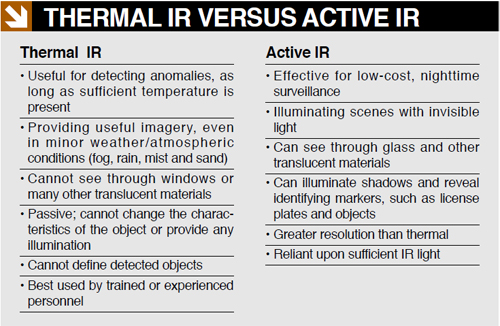Thermal cameras produce clear images in pitch darkness and through all weather conditions, compensating for the low-light disadvantages of other security cameras. Furthermore, they eliminate shadows, looking into hiding places for potential criminal activity.
Thermal cameras produce clear images in pitch darkness and through all weather conditions, compensating for the low-light disadvantages of other security cameras. Furthermore, they eliminate shadows, looking into hiding places for potential criminal activity.
The 2008 to 2009 global recession effects were evident in slow construction, tight security budgets and dwindling camera sales. “Our market share was roughly divided into 55 percent thermography and 45 percent for security, surveillance, firefighting and military applications combined,“ said Jean-Luc Tissot, Marketing and Technical Director for ULIS. Despite tough conditions, new verticals, markets and applications have opened up, particularly in emerging and developing countries.
The typical applications for thermal cameras include perimeter, transportation and any type of company or industry in need of being closely monitored, said Peter Lindstrom, Director of Business Development for Axis Communications. “These include railroads, highways — in short, anything long and straight. Another area that requires thermal cameras is area protection, which includes parking lots and school yards where night surveillance is crucial.”
Airports are the perfect channels of ushering in and out fatal diseases. When SARS and HIN1, both deadly, broke out in recent years, passenger temperature scans were installed to identify anyone with above-normal body temperature. “During the outbreak of SARS, airports became one of the biggest verticals that applied thermal IR cameras,” Tissot said. Thermal cameras are used for flu detection, mostly in Asian countries, and military and other purposes in the U.S. and Europe.
Monitoring and energy efficiency make use of thermal imaging. “Other applicable fields include building control, where you can test for any heat leaks which ultimately consume energy,” Tissot said. “On the surveillance side, people can be easily detected without the need of light. Furthermore, it is feasible that one thermal camera can make up for roughly 500 analog cameras, although they do complement each other.”
Thermal IR
The differences in thermal cameras can be attributed to two types of sensors — cooled IR image sensors based on photo detection and uncooled IR image sensors based on thermal detection.
Cooled IR
Cooled sensors need cooling circuits for them to operate. Without the circuits, the sensors would be flooded by their own radiation. However, cooled sensors are expensive to produce, power-hungry and time-consuming — they need several minutes to cool down before they can work again.
Despite their bulky size and higher cost, cooled sensors provide superior image quality compared to uncooled ones. Furthermore, cooled sensors have greater sensitivity, suited for higher F-number lenses for a tighter focus.
It should come as no surprise that cooled sensors are used more in high-end thermal IR cameras. “High-end thermal cameras use cooled technology which requires active cooling components and regular maintenance,” Lindstrom said. “Entry-level to mid-range thermal cameras use uncooled technology which is a new technology without active cooling. If you need real high performance, you should choose cooled cameras, but for security and surveillance, one should always use uncooled technology.”
Uncooled IR
Unlike their cooled counterparts, uncooled sensors operate at ambient temperatures and reduce noise without cryogenic coolers. This allows them to be smaller and cheaper. Wide spectral responses and longer periods of operation are compromised by lower resolution and image quality.
However, recent advances in uncooled sensor technology have improved the fabrication process of uncooled sensors. In the past, sensor materials have included vanadium oxide, lead titanate and amorphous silicon.
Amorphous silicon offers three advantages — low power consumption, solar-immunity design and sharp images of moving objects. “Amorphous silicon microbolometers are characterized by a small thermal constant of less than 10 milliseconds and, therefore, are less sensitive to the smearing effect that often appears when fast-moving objects are imaged,” Tissot said. “They also reduce the time needed to obtain the image once the camera has been turned on. Because the sensor does not need to be heated or cooled to reach operating temperatures, it works almost instantaneously.”
 Opti mum Performance
Opti mum Performance
For night cameras, IR-corrected lenses with anti-reflection, wide apertures and illumination are important. Lenses combined with the resolution ensure optimal thermal performance. “The resolution has to be 384 by 288, compared to HD which is 920 by 1,080, and the choice of lens depends on the transmission and how much thermal radiation passes through it,” Lindstrom said.
Other factors include the F-number and processing power. The more the processor calculates, the more noise is reduced. “The mechanics are very important, so temperature differences must be considered,” Lindstrom said.
Emissivity
Thermal cameras rely on the transmission of heat and temperature. However, if two objects or persons were the same temperature, emissivity is the key factor in distinguishing them. “Emissivity, as well as temperature, enables the contrast of IR,” Tissot said. “Thus, objects or people with identical temperatures will not prove to be a problem.”
Thermal cameras are also extremely sensitive when it comes to accuracy, being able to detect the difference between 0.1 degree Celsius. “A car and asphalt may share the same temperature,” Lindstrom said. “However, they have different emissivity.”
 Through Smoke and More
Through Smoke and More
Although thermal cameras can see through total darkness, they are still far from perfect. Atmospheric
conditions such as light fog, rain and snow affect the detection range. The extent is relatively low compared to traditional analog cameras. “Rain, in particular, is tough because when it rains, the temperature is evened out on everything — surroundings, people, cars and more,” Lindstrom said.
Detection and identification are top priorities for security. Thermal handheld cameras enter the picture, especially for firefighters to see through smoke, find people and locate fires. “Usually, if it is a child that starts the fire, he or she doesn't leave the room because their first instinct is to hide,” Lindstrom said. “This makes this kind of technology especially useful in such a critical situation.”
Sensor-wise, handheld and fixed IR cameras are generally the same. “Camera difference could arise in the range of detection,” Tissot said. “For handheld thermographic cameras, the total range is typically up to 10 meters and uses a smaller, 160-by-120 sensor. For high-end, fixed surveillance cameras, the range is larger and wider, with a 320-by-240 sensor or larger, like VGA format.”
Thermal cameras are able to secure areas while acknowledging privacy concerns. “Looking from an algorithm perspective and for privacy purposes, IR cameras work extremely well, especially for applications that do not need to identify people's faces,” Tissot said.
Thermal imaging's poor identification aspect is compensated in other areas. “Where there is a lack of distinction, we make up for in detection,” Tissot said. “For firefighters, IR works even better than visible cameras because longer wavelengths enable less diffusion. In terms of security and surveillance, IR cameras can be combined with alarms to simultaneously detect and identify.”
Thermal network cameras are notorious for power source instabilities. While recent advances have circumvented this problem, power is still more complicated compared to analog cameras. “We use PoE for the customers that prefer this power source, but we also have a traditional power connector if you prefer that,” Lindstrom said. “In professional installations, you usually have a UPS on the switch side to make sure that the cameras always have a reliable power source via PoE.”

Future Directions
The future of thermal cameras includes more applications in different verticals. Development efforts will focus on lenses with better image quality, video analytics and increasing the sensitivity of CMOS sensors. “The speed for making CMOS sensors more sensitive than CCDs is fast on the rise, especially as they go through HD cameras,” said Ad Biemans, EMEA Product Marketing Manager for CCTV, Bosch Security Systems. “Furthermore, there will be more interest in thermal imaging as quantities increase and prices come down.”
Setting Standards
Axis plans to standardize lenses for thermal cameras. “In the past, lenses cannot be exchanged, thus making it less convenient for users who wish to use products from different manufacturers. Our goal is to standardize ta-lens lenses by providing the specifications to other manufacturers,” Lindstrom said. “Currently, we've introduced four different lenses with four ranges, where the wide range enables you to see a person 200 meters away, and a bigger range lets you see a person 1,200 meters away.”
Tissot added that standardization will extend to image sensors. “Currently, there are no existing standards for sensors,” he said. “The future direction of thermal cameras will, thus, work on making sensors easier and smarter to operate.”
Affordability
Prices for thermal cameras remain considerably higher than standard cameras, despite markdowns in recent years. As commercial applications are more concerned about short-range detection for automotive and firefighting purposes, pricing can be adjusted for certain elements. “Therefore, some manufacturers do not require high-sensitivity detectors but affordable detectors for addressing large-volume production,” Tissot said.